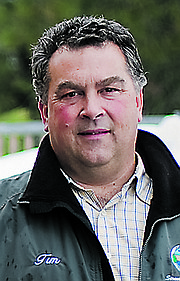Cd'A drivers stuck in red-light district
So, you just missed that traffic light on your way to work.
And doggone it, when you hit this red, the next one is almost always about to turn red, too.
Grrrrrrr...
Is the city punishing you on purpose?
“I have to chuckle because everyone in Kootenai County thinks that’s what we do,” said Tim Martin, Coeur d’Alene’s streets and engineering director.
“But it’s not true. Really.”
Martin’s defense is based on technology — or lack of it.
“Our signals aren’t new enough to talk to each other,” he said. “Newer signals have fiber-optic or wireless capabilities, and they actually can talk to each other. That gives you the opportunity to set up a traffic flow you’d like, but we can’t do it.”
Coeur d’Alene’s traffic signals — there are 42 of them at the moment, plus another 13 that belong to the Idaho Transportation Department — get their messages from three tried and mostly true methods.
There are some with cameras, others with loops under the asphalt, and the rest with pucks.
“Yes, they’re called pucks because they do look like hockey pucks and they’re put in the ground,” Martin said. “The idea is to let a traffic signal box know that you’re there.
“One problem that winds up frustrating drivers is that people will be stopped at a light and they quit paying attention. Maybe they’re texting or talking to someone.
“If they delay a little bit when the light changes, they’re late tripping the puck that’s 20 feet or 40 feet from the intersection, and the light will cycle back to red more quickly — meaning some cars farther back in line might miss it.”
Martin politely urges all drivers to keep their minds on the task, for their own safety but also to keep things moving.
It turns out that even if Martin and Chris Bosley, the city engineer, wanted to synchronize several sets of signals around town, the task would be pretty much impossible.
“If you’re going north-south and crossing I-90, you might hit two or three red lights in a row,” Martin said. “But the lights at the interstate belong to ITD, so even though we’re contracted to fix them when there’s a problem, those belong to the state.
“The same thing is true with the signals on U.S. 95. Those belong to the ITD.”
Motorists no doubt sigh when they hear these explanations — which they do, frequently, because Martin and his staff take calls almost non-stop.
“Sometimes we feel like 911 dispatchers,” he said.
Actually, the issues that prevent synchronizing signals and making your driving life easier just go on and on.
For instance, pedestrians are a problem.
Coeur d’Alene merchants love their summer tourists, but those folks have a major impact on traffic. Hitting a button to cross a busy street — say, Sherman Avenue — naturally will produce a red light for motorists more quickly.
“That would be OK if people did it properly,” Martin said, “but they get impatient and start pounding on that button. Eventually the spring jams and the signal thinks it has to change the light accordingly.
“I wish everyone would just push the button once, be patient and wait.”
Then there’s the matter of cost and manpower to keep signals operating.
Tax dollars are needed to purchase and maintain these traffic signals, and each one can cost $25,000 to $30,000.
Martin’s department has 35 full-time employees and anywhere from 10 to 16 part-timers — but those doggone signal lights are hardly their only concern.
They clear snow in the winter and try to keep things moving during what residents probably call “construction season.”
“Oh, sure, we hear plenty about that,” Martin said. “That’s an issue where human nature affects the flow of traffic and red lights can become more of a problem.
“For instance, there’s work being done now on Atlas, so drivers know that and use Ramsey instead of their normal route. So then traffic piles up on Ramsey and people don’t understand why they keep missing green lights.
“I mean, we would love to have the lights lined up on a few routes — a good example might be Government Way from Harrison to Canfield — and there actually will be some places where it can work.
“But remember the ages of the signal boxes at a lot of these places. There are so many things that have to be aligned.”
Martin believes when you look at the big picture, traffic signal frustrations are part of growth.
“When Coeur d’Alene and the area around it are fully built up, it will be easier to make adjustments,” he said.
“But I hope people understand that we have to do it one corridor at a time, and their tax dollars are going to pay for it, so...”
Yes, message received.
Prepare for that next red light.



